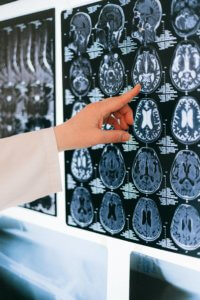An announcement of the results of some leading-edge research by Israeli scientists into cognitive degeneration is giving some glimmer of hope that a cure for Alzheimer’s disease may be more than just a dream.
A research team from Bar-Ilan University discovered that there might be a link between decreased brain wave activity and the level of cognitive impairment in neurodegenerative diseases such as Alzheimer’s disease.
The following is a short explanation of how a healthy brain works, and what could be going wrong when there is a neurodegenerative disease

A healthy brain is not just a matter of how well it performs, but also how it performs. The brain has different ways of operating that are called the alpha, beta, delta and theta waves. These waves are not just related to performance of the brain but also to its health.
Entrainment is a process where your brain synchronizes two different rhythms in order to establish a third one that is only produced by combining two other rhythms. The alpha waves are associated with a relaxed state while beta waves with an active state of mind. Theta waves are associated with dreams and meditation.
Some of the most important benefits of theta waves produced by brainwave entrainment include:
- Deep relaxation
- Improved focus and concentration
- Enhanced mental alertness and creativity
- Heightened sense of well-being, tranquility, and peace
- Improved mood and feelings of happiness
- Enhanced learning capability.
So by combining the higher frequency alpha waves with the low frequency theta waves you create a middle tone – beta waves. The beta waves are largely associated with focus and clarity.
Findings in the new Bar Ilan research focus on how exactly brain waves transmit information, and whether this can mean there’s a link between decreased brain activity and neurodegenerative diseases.
The team is trying to understand how the brain uses the waves to transfer information between different areas along the connecting nerves (neurons). This has led to showing that varying levels of neural synchronization can have an impact.
What are some of the current treatment options for Alzeimer’s patients?
Although no cures for the degenerative disease have been found yet, some prescribed medications are already being used to either slow down the onset or to lessen the degree of impact. Amongst them are:
Namenda from Denmark (with active ingredient memantine) which partially blocks the activity of glutamate. Excessive glutamate contributes to the symptoms of Alzheimer’s and its progression.
Aricept from France (with active ingredient donepezil) which is used to treat mild to moderate dementia. It prevents the breakdown of acetylcholine which is important for the processes of memory, thinking, and reasoning. People with dementia usually have lower levels of this chemical.
Exelon from Switzerland (with active ingredient rivastigmine) has the same effect as Aricept, working to maintain the levels of acetylcholine.
Razadyne from Italy (with active ingredient galantamine Hbr) which acts to boost the levels of acetylcholine in a different way. It slows the breakdown of acetylcholine and also enhances its activity.
Reminyl from Italy (with active ingredient galantamine Hbr) works the same way as Razadyne.
Although these drugs are not curing Alzheimer’s, they do work to improve the lives of people who would otherwise be suffering steadily worsening symptoms of the disease.
What are brain waves?
Neuroscientists have researched brain waves for more than 120 years. They are an essential diagnostic tool, when doctors read them in an EEG (electroencephalogram) which shows the transmitting of information between different regions of the brain.
Brain waves are produced through the activity of thousands of nerve cells as they transmit information in waves between regions of the brain. Studies have shown that changes in brain wave frequency and intensity could indicate neurodegenerative diseases like Parkinson’s and Alzheimer’s as well as disorders such as epilepsy and autism.
A sudden decrease in wave intensity at a specific frequency is a characteristic of Alzheimer’s disease, whereas a spike in the delta wave may characterize epilepsy,
In the new Israeli research, the doctors were looking primarily at the waves produced when new smells are detected because the sense of smell stimulates intense brain wave activity. The surprising result that they discovered is that synchronizing neurons by special stimuli led to a significant improvement in the transmission of the information to the target area of the brain even though there was a decrease in the activity level in the area producing the waves.
They should have seen less information being transferred to the target region, but now because the waves are synchronized, this compensated for the reduced activity and improved the transfer of data.
Conclusions
Now there is some hope that a solution could be found that produces the same kind of synchronization through simple stimuli. It could lead to a treatment, so that when neurons are synchronized, the transmission of information between regions in the brain will be done more powerfully than when each neuron operates independently. This could be a breakthrough in finding a way to treat Alzheimer’s patients, in which the levels of wave strength have fallen. So far, there have been no methods that can slow down the disease, let alone reverse it.
FAQ
What are the Symptoms & Causes of Cognitive Impairment?
Currently, it is understood by researchers that brain activity is the level of mental energy that is being used by the brain. Brain activity can be reduced by many factors such as sleep deprivation, stress or even low blood sugar levels.
When someone’s brain activity decreases, they will start to experience fatigue, tiredness and a lack of ability to concentrate. These are all symptoms of cognitive impairment evident in people suffering from Alzheimer’s.
Cognitive impairment can compromise decision-making, problem-solving skills, socialization and judgment. A person with cognitive impairment may experience difficulty in remembering recent events, problem-solving, or concentrating. They may also have difficulty with language and communication skills, such as reading and writing.
Symptoms of decreased brain activity can be caused by a variety of factors such as aging, Alzheimer’s disease, stroke, traumatic brain injury (TBI), Parkinson’s disease, and other neurological disorders. A general cause of decline in brain activity is “aging.” The average age of onset for Alzheimer’s disease (which is a type of dementia) is 65.
Understanding Alzheimers
Dementia is a memory-related disease characterized by deterioration of cognitive and behavioral functions such as language comprehension and planning. Alzheimer’s disease is the most common form of dementia, affecting 5% to 6% of people over 65 in the United States. It affects about 50% of those over the age of 85.















